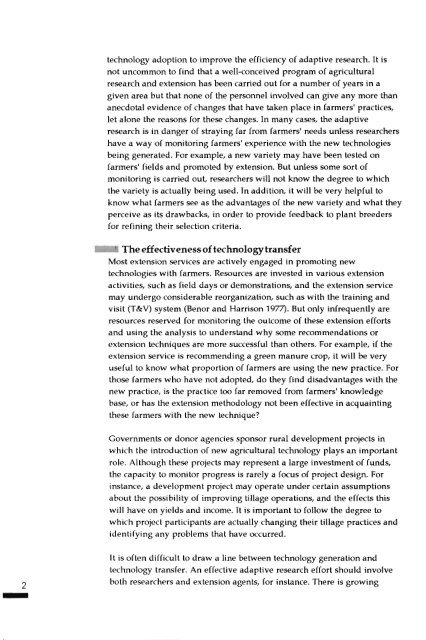The Adoption of Agricultural Technology - Food Security Group
The Adoption of Agricultural Technology - Food Security Group
The Adoption of Agricultural Technology - Food Security Group
You also want an ePaper? Increase the reach of your titles
YUMPU automatically turns print PDFs into web optimized ePapers that Google loves.
technology adoption to improve the efficiency <strong>of</strong> adaptive research. It isnot uncommon to find that a well-conceived program <strong>of</strong> agriculturalresearch and extension has been carried out for a number <strong>of</strong> years in agiven area but that none <strong>of</strong> the personnel involved can give any more thananecdotal evidence <strong>of</strong> changes that have taken place in farmers' practices,let alone the reasons for these changes. In many cases, the adaptiveresearch is in danger <strong>of</strong> straying far from farmers' needs unless researchershave a way <strong>of</strong> monitoring farmers' experience with the new technologiesbeing generated. For example, a new variety may have been tested onfarmers' fields and promoted by extension. But unless some sort <strong>of</strong>monitoring is carried out, researchers will not know the degree to whichthe variety is actually being used. In addition, it will be very helpful toknow what farmers see as the advantages <strong>of</strong> the new variety and what theyperceive as its drawbacks, in order to provide feedback to plant breedersfor refining their selection criteria.<strong>The</strong>effectiveness<strong>of</strong>technologytransferMost extension services are actively engaged in promoting newtechnologies with farmers. Resources are invested in various extensionactivities, such as field days or demonstrations, and the extension servicemay undergo considerable reorganization, such as with the training andvisit (T&V) system (Benor and Harrison 1977). But only infrequently areresources reserved for monitoring the outcome <strong>of</strong> these extension effortsand using the analysis to understand why some recommendations orextension techniques are more successful than others. For example, if theextension service is recommending a green manure crop, it will be veryuseful to know what proportion <strong>of</strong> farmers are using the new practice. Forthose farmers who have not adopted, do they find disadvantages with thenew practice, is the practice too far removed from farmers' knowledgebase, or has the extension methodology not been effective in acquaintingthese farmers with the new technique?Governments or donor agencies sponsor rural development projects inwhich the introduction <strong>of</strong> new agricultural technology plays an importantrole. Although these projects may represent a large investment <strong>of</strong> funds,the capacity to monitor progress is rarely a focus <strong>of</strong> project design. Forinstance, a development project may operate under certain assumptionsabout the possibility <strong>of</strong> improving tillage operations, and the effects thiswill have on yields and income. It is important to follow the degree towhich project participants are actually changing their tillage practices andidentifying any problems that have occurred.-2It is <strong>of</strong>ten difficult to draw a line between technology generation andtechnology transfer. An effective adaptive research effort should involveboth researchers and extension agents, for instance. <strong>The</strong>re is growing



